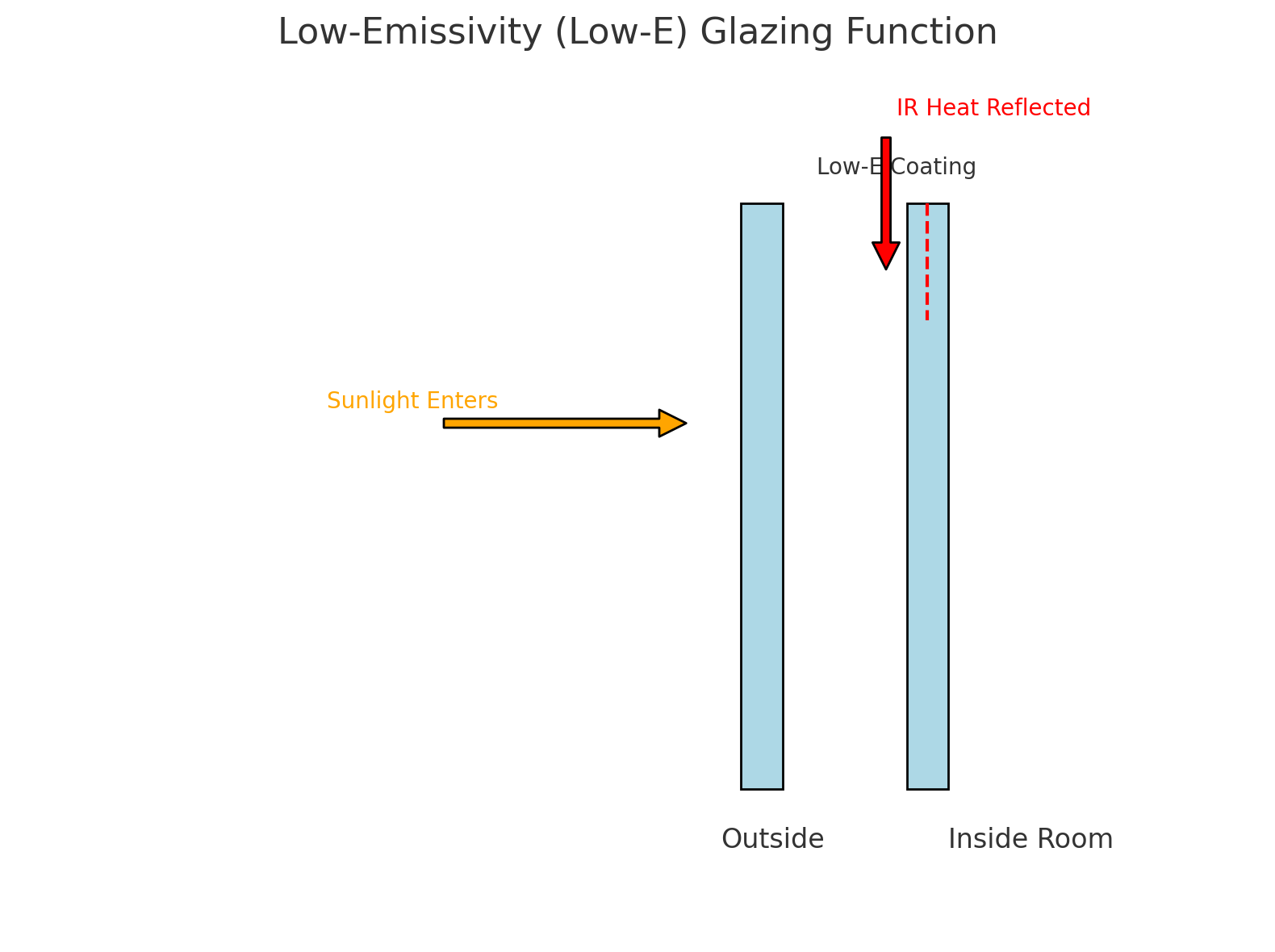Energy Management Systems
1/44
There's no tags or description
Looks like no tags are added yet.
Name | Mastery | Learn | Test | Matching | Spaced |
|---|
No study sessions yet.
45 Terms
Briefly explain the Second Law of Thermodynamics
Heat always flows from a hot object to a cooler one.
Explain what we mean when we say energy is consumed or 'used- up'?
Energy itself is not consumed. It is converted from one form to another, usually a
low- entropy ( chaos) form to high entropy form. Only low entropy forms of energy
are useful to us to perform work. It is the fuels which are consumed ( converted from
low entropy to high entropy forms of energy). eg. car engine, the fuel's stored
chemical energy is converted into heat and then into kinetic energy to move the car.
another eg. wind turbine extracts kinetic energy from the wind , converts it to
electrical energy which may be converted into light energy when filament of lamp is
heated.
UUse a sketch to describe the use of a norm chart to display energy
consumption

The lights in a warehouse remain on for 10 hours and consume 15 units of
electricity. What is the wattage of the lighting system?
15 units = 15 kWh.
for 10 hours.
Wattage = 15/10 = 1.5 kW = 1500 W
Briefly explain 3 reasons why we should prioritise energy management?
1. fossil fuels are a finite resource
2. To reduce man's impact on the environment, climate change due to burning of
fossil fuels.
3. Security of supply.
Explain why glazing is known as the thermal weak link in buildings. How can its
impact be reduced?
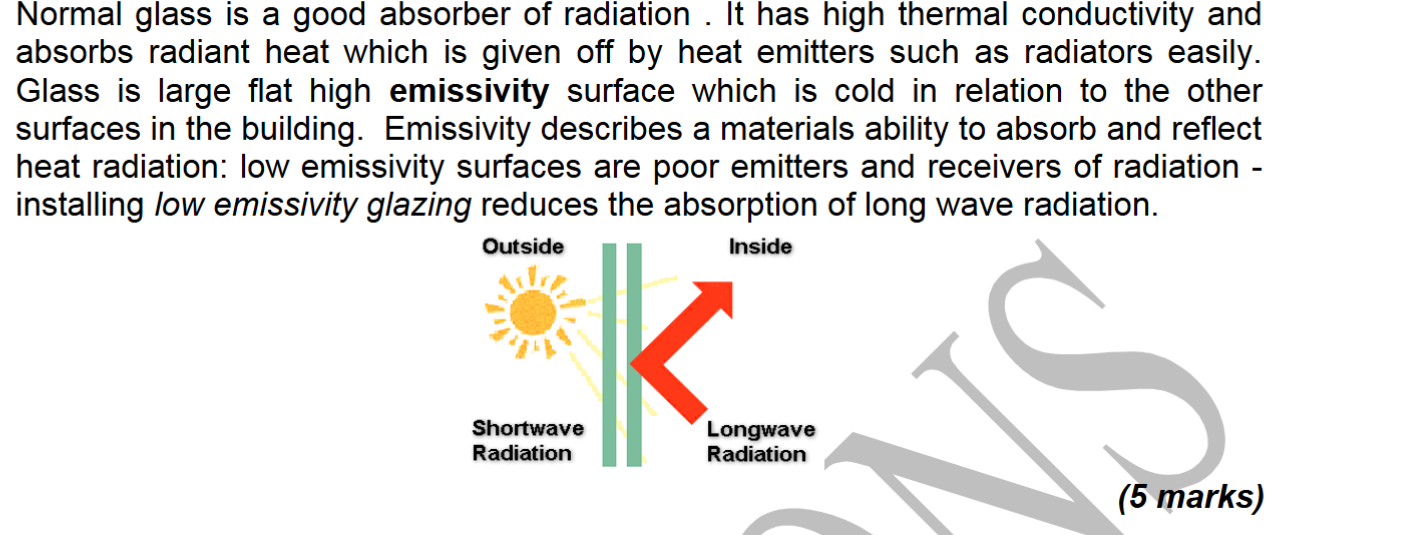


Outline the aim of an energy audit, and list the steps involved in carrying out an
energy audit
The aim of an energy audit is to identify viable and cost effective energy measures
which will reduce energy costs. The process usually involves:
- collect data from utility bills, meters
- undertake survey of equipment and meters
- collect info from various personnel.

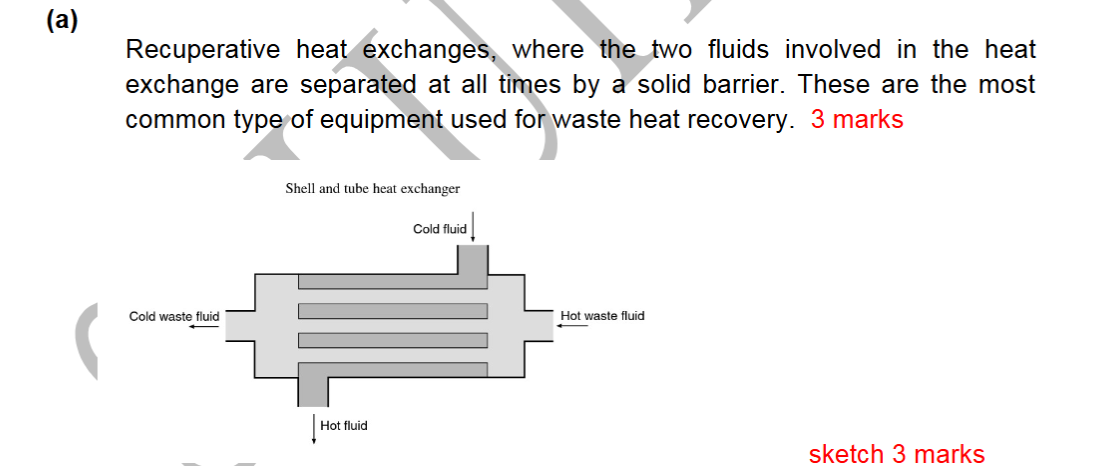

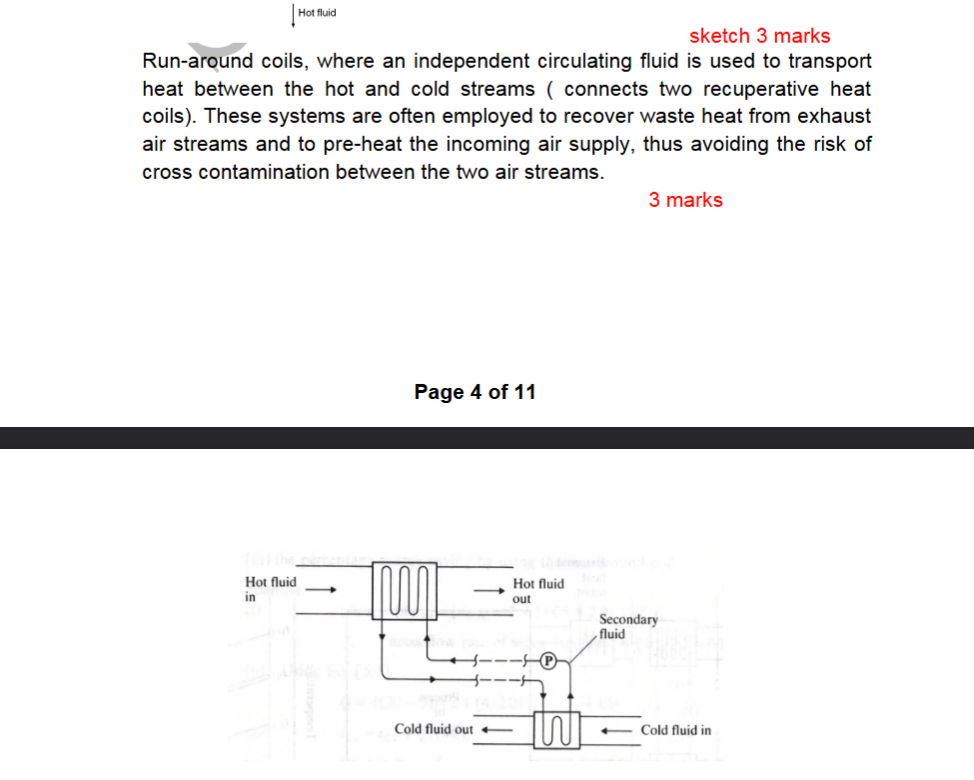
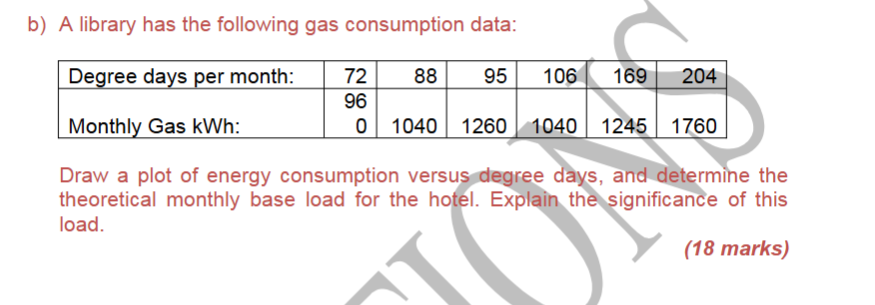

The surface areas and U values for the components of a building are shown in
the table below. If the internal temperature is 21 degreesC, and the external
temperature is -1 degreeC, determine the design heat loss rate (J/s). Include
fabric heat loss and ventilation heat loss and assume that the building
experiences 3 air changes per hour and that the volume of the building space
is 1000m3.
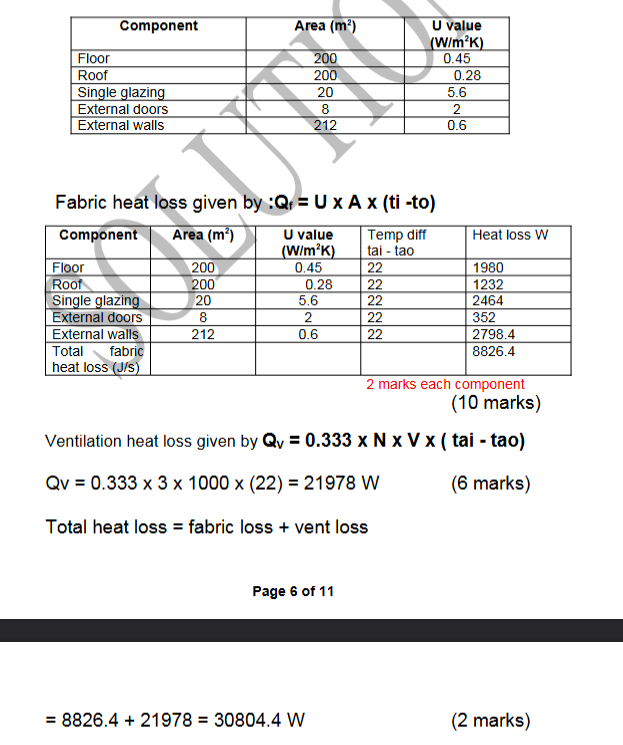
Comment briefly on the results and give 3 suggestions which would reduce the
energy consumption in this buildingg
Ventilation losses by far the largest culprit- about 70% of total. Ensure ventilation is
not excessive ( exceeding building regulation requirements) Seal door and windows,
ensure vents not too large etc. Next glazing and wall fabric losses. Double glazing
would halve glazing losses and low emissivity glass would also reduce losses.
Ensure insulation in walls is adequate and consider improving it.
Conduction, which is the transfer of heat energy through matter, such as atoms and
molecules. If you hold the end of a metal rod in a flame, the end that you are holding
quickly becomes hot. Energy is transferred through the rod. No part of the rod
moves; energy is transferred from one atom to another within the rod. This process
is known as conduction. 4 marks
Convection, which is heat transfer influenced by air temperature and air velocity.
This takes place continuously although it may not be noticeable in all buildings
because speeds are low. An example of convection is water being heated in a pot on
a stove. The water at the bottom heats up first by conduction through the pot from
the stove. When the water heats up, it becomes less dense, rises to the top surface,
to be replaced by the colder water which is heated in turn. These currents are called
convection currents. 4 marks
Radiation, which is heat transfer in the form of electromagnetic waves influenced by
the mean radiant temperature of the surfaces. The sun, fires and light bulbs emit
electromagnetic waves, and when the energy of such waves is absorbed, it can have
the same effect as heat.
Direct gain system( four basic approaches to passive solar heating)
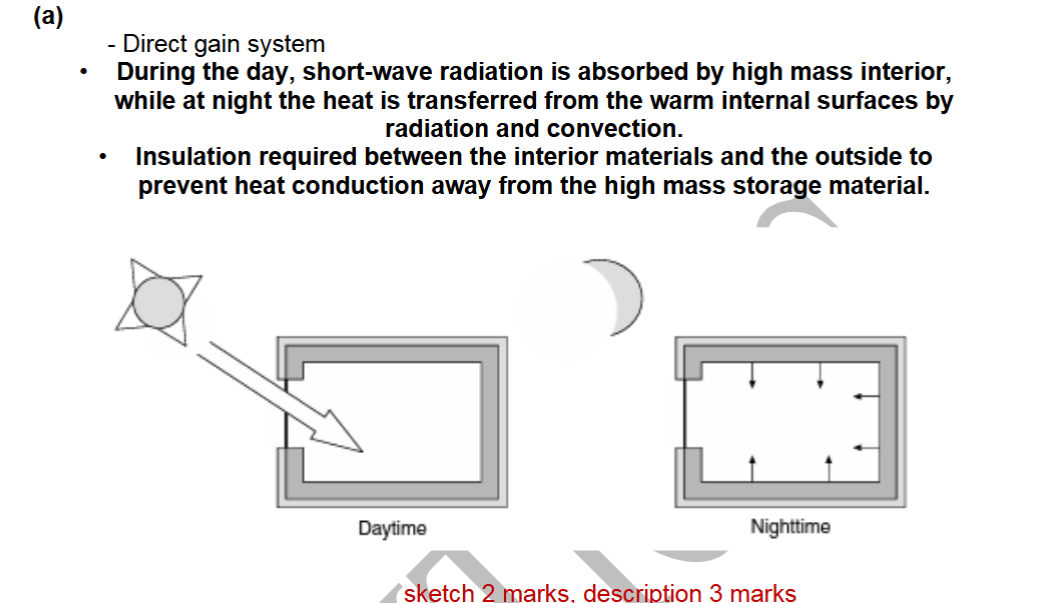
Indirect gain system( four basic approaches to passive solar heating)
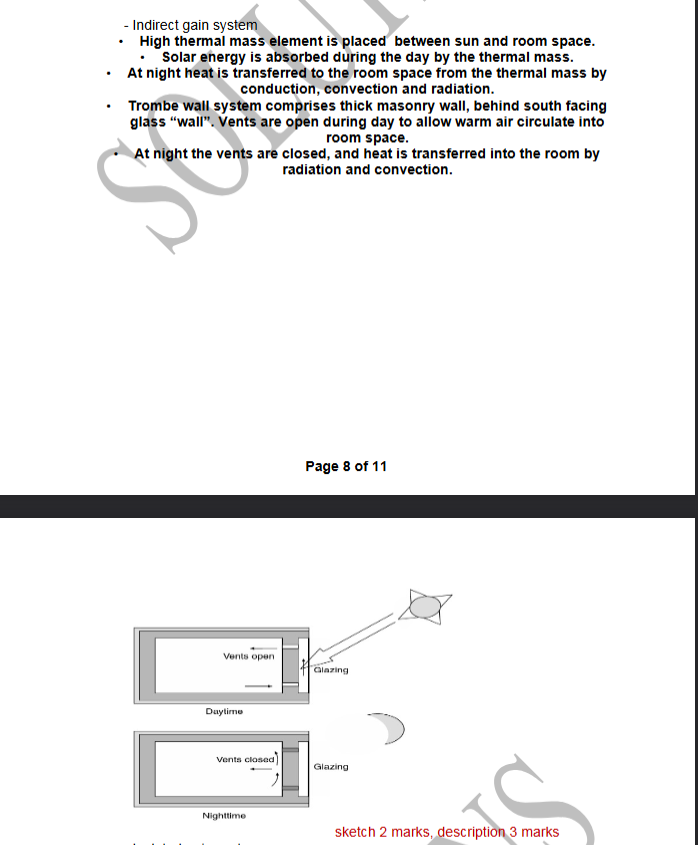
Isolation Gain System( four basic approaches to passive solar heating)
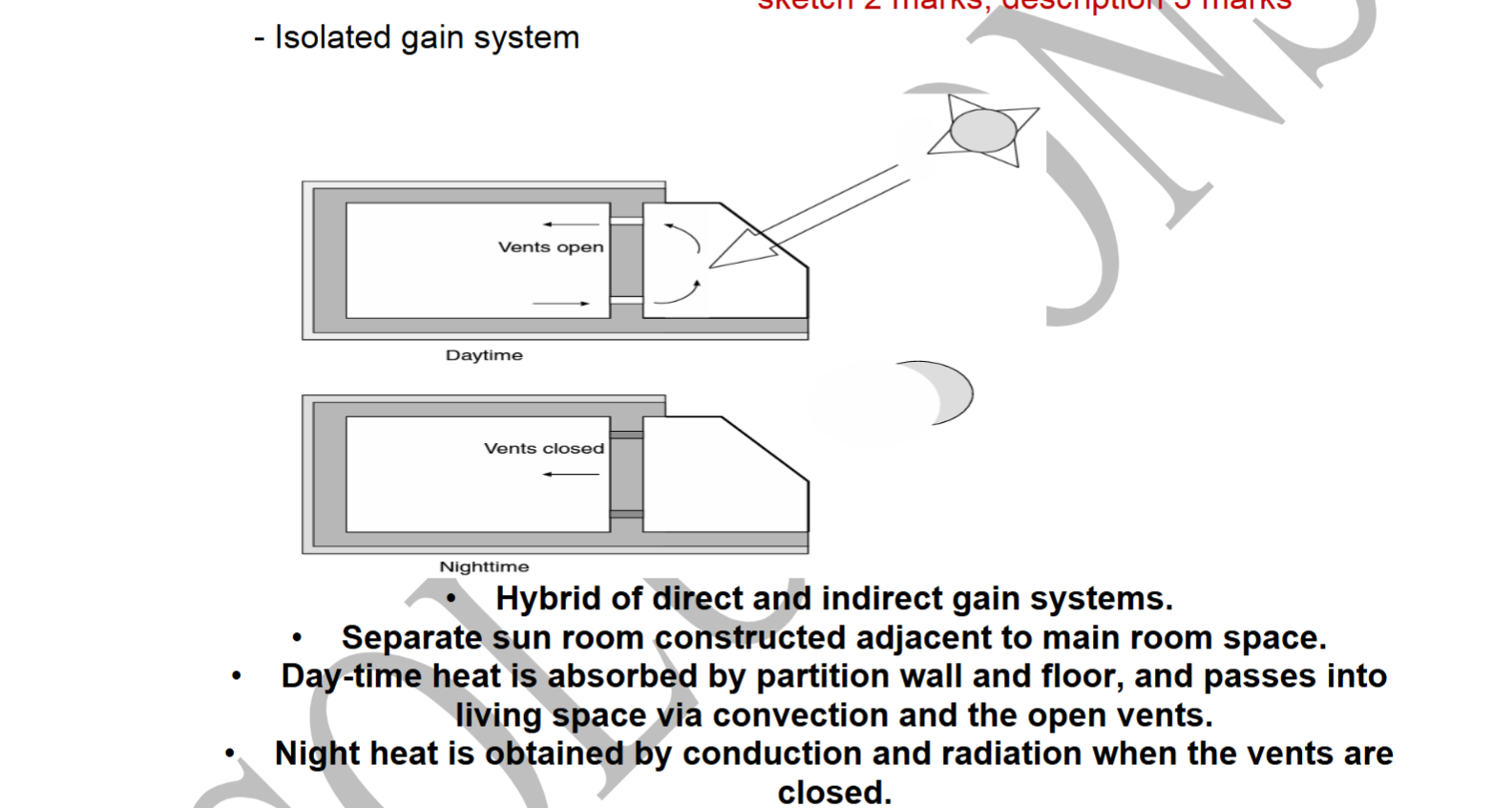
Thermosiphon System( four basic approaches to passive solar heating)
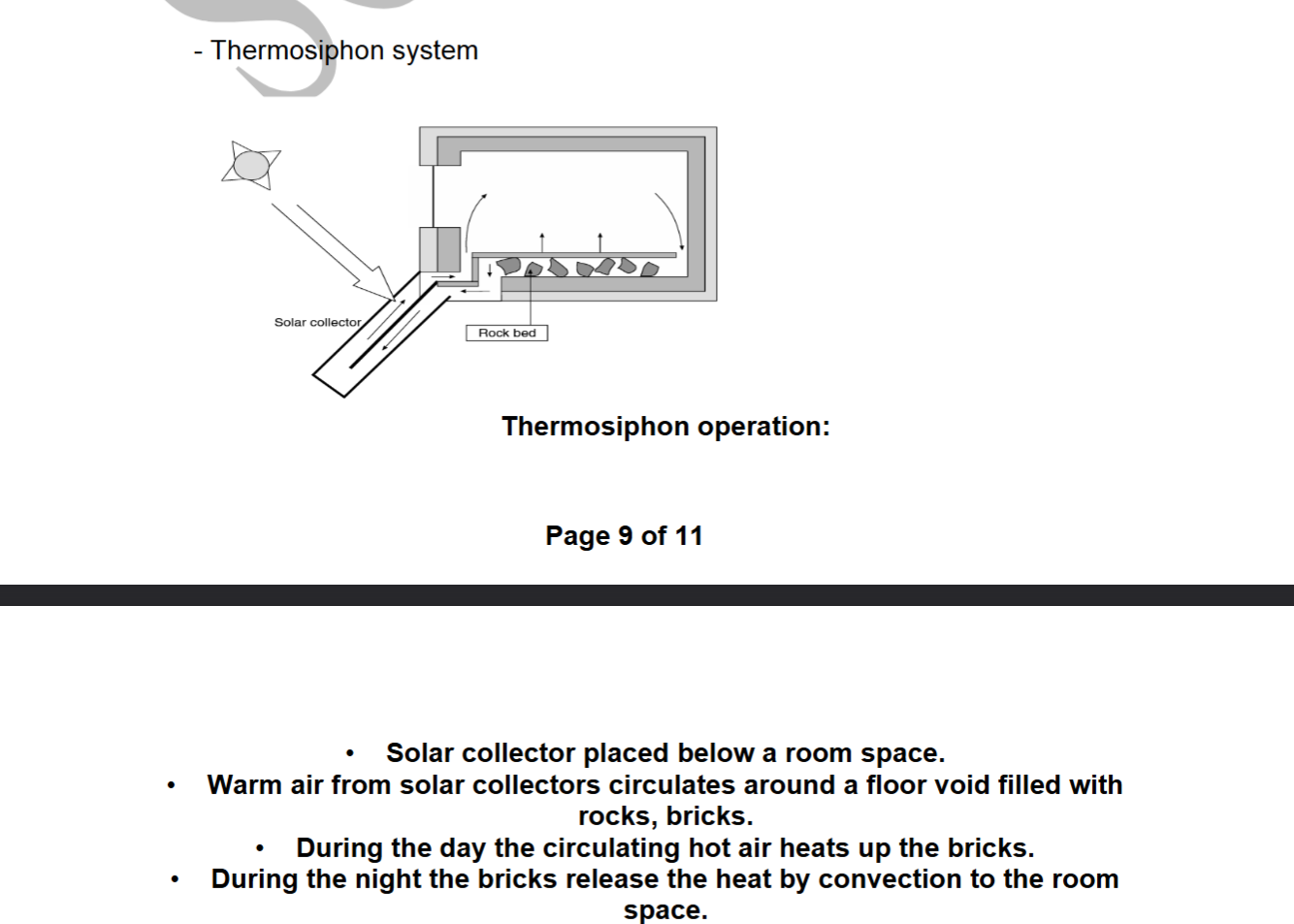
Explain the benefits and operation of modulating burners
In general, boiler efficiency falls dramatically below about 30% of rated capacity.
Large, oversized boilers will be operating below their rated capacity and will operate
inefficiently It is important that a boiler installation is designed to operate efficiently at
part load. Good part load efficiencies can be obtained with modulating burners.
The significant fuel savings (up to 15%) and efficiency are achieved by: System runs with the minimum input needed to meet the required demand
Reductions in temperature setpoint overshoot. Modulating burners modulate the fuel and air to provide a variable output from
approximately 20% to 100%. Fuel and air are always in proper balance for maximum
combustion efficiency.
Briefly explain the operation of a run-around coil heat exchanger,
using a sketch to support your answer
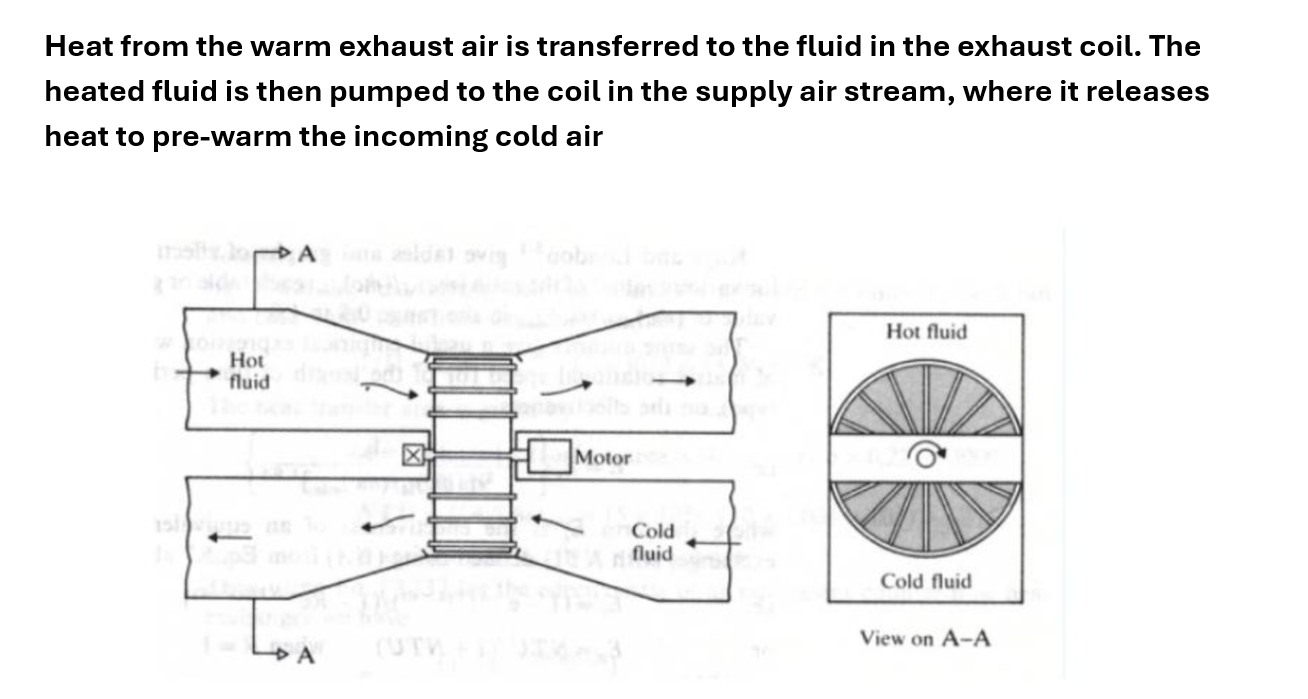
Calculate the fabric loss in watts through a floor of area 250m2, if the
U value of the floor is 0.45 W/m2K, the inside temperature is 20 C
and the external temperature is -1 C

Calculate the kWh equivalent of 3,000 m3 of natural gas, given that
there are 38.6MJ of energy per m3 of natural gas.

The open-circuit voltage of a photovoltaic solar module is specified as
22 volts. Its short circuit current specification is 3 amps. Sketch on the
same graph, the V-I characteristics of the module at both 25C and at
75C. Estimate the power rating of the module.
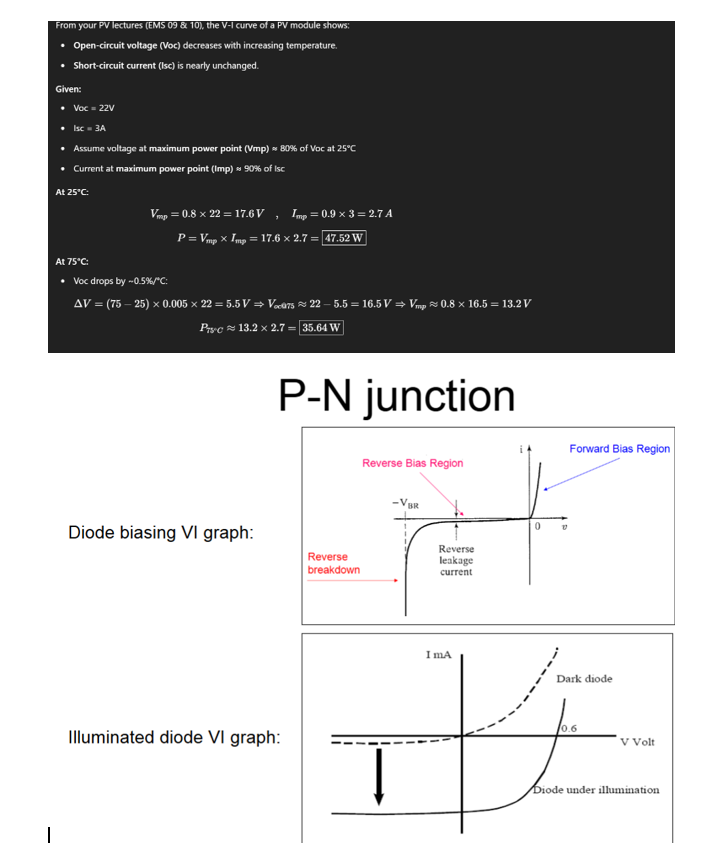
Deviance Charts
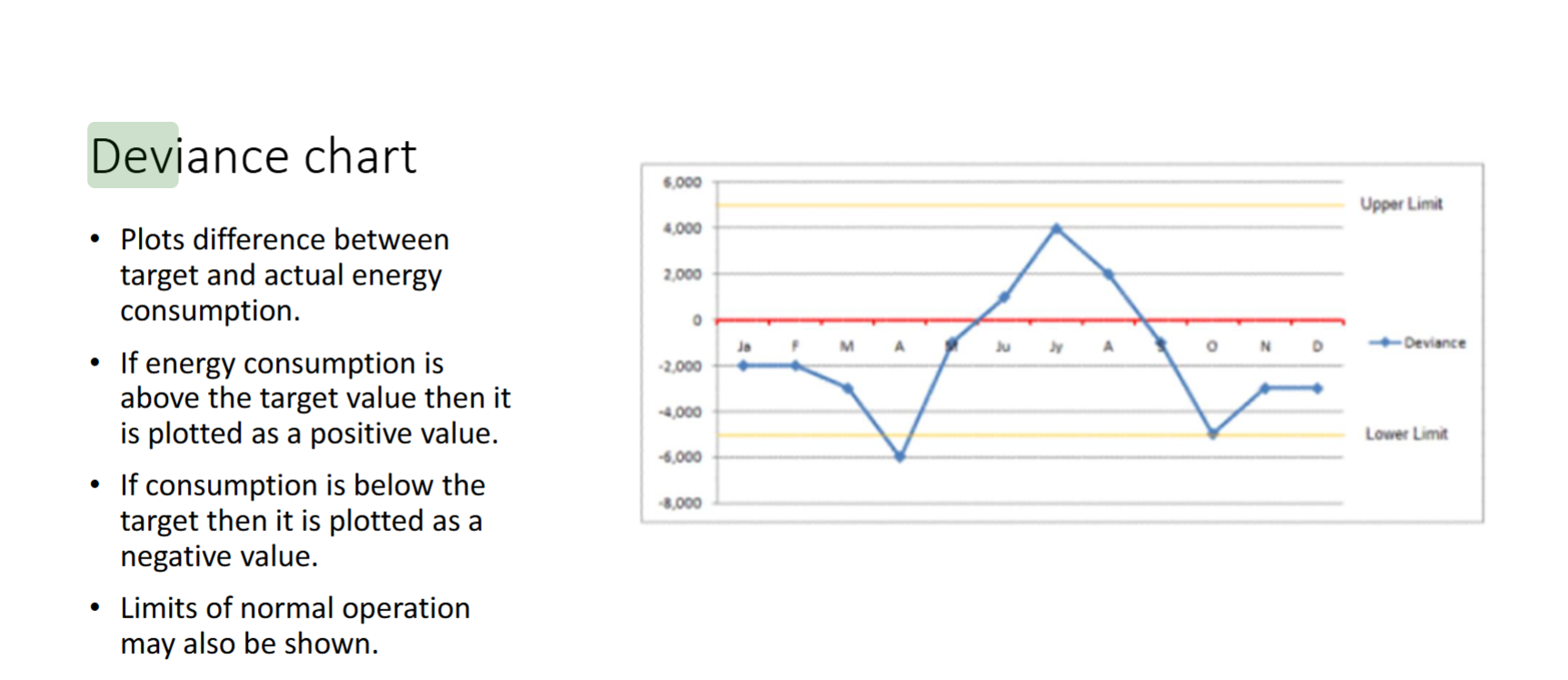
List and briefly explain five features of a renewable energy source
1.Environmentally Clean
They do not emit gas or liquid pollutants during operation.
2.Inexhaustible Supply
Derived from natural, continuously replenished resources like the sun, wind, or geothermal heat.
3.Local Resource Control
Can be produced and managed locally, reducing reliance on imported fuels.
4.Energy Supply Diversification
Adds resilience and variety to national energy mixes, improving energy security.
5.Minimal Operating Emissions
Operate silently and without harmful by-products, though some (like wind farms) may have localized environmental impacts.
A 220 V single-phase A.C. motor consumes an average input power of 0.3 kW and draws an RMS current of 1.55 A. Determine the power factor of the motor and the phase angle.
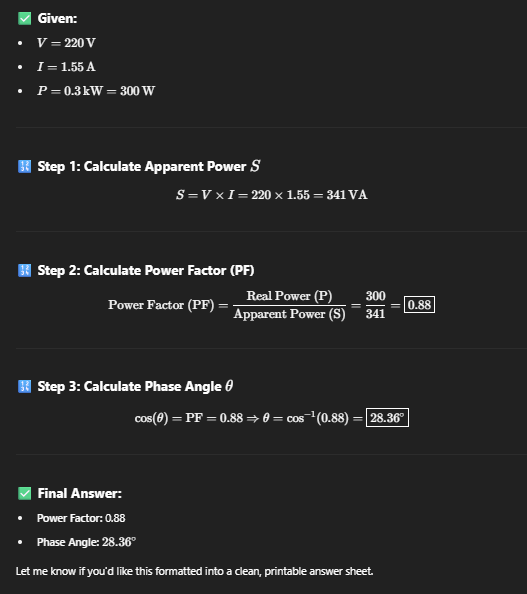
A wind turbine is designed to produce an output power of 200 kW
in a 11.5 m/s wind stream. Calculate the minimum blade length
that would achieve this.
Density of air is 1.2 kg/m3.
Design efficiency: 20%

Explain, using a diagram, the operation of a solar tube (heat pipe)
collector
Absorber is located in an evacuated and pressure proof glass tube. The heat transfer fluid flows through the absorber directly in a U-tube or in countercurrent in a tube-in-tube system. • Several single tubes, serially interconnected, or tubes connected to each other via manifold, make up the solar collector. • A heat pipe collector incorporates a special fluid which begins to vaporize even at low temperatures. The steam rises in the individual heat pipes and warms up the carrier fluid in the main pipe by means of a heat exchanger. The condensed liquid then flows back into the base of the heat pipe.
The pipes must be angled at a specific degree above horizontal so that the process of vaporizing and condensing functions. • There are two types of collector connection to the solar circulation system. Either the heat exchanger extends directly into the manifold ("wet connection") or it is connected to the manifold by a heat-conducting material ("dry connection"). • A "dry connection" allows to exchange individual tubes without emptying the entire system of its fluid. • Evacuated tubes offer the advantage that they work efficiently with high absorber temperatures and with low radiation. Higher temperatures also may be obtained for applications such as hot water heating, steam production, and air conditioning
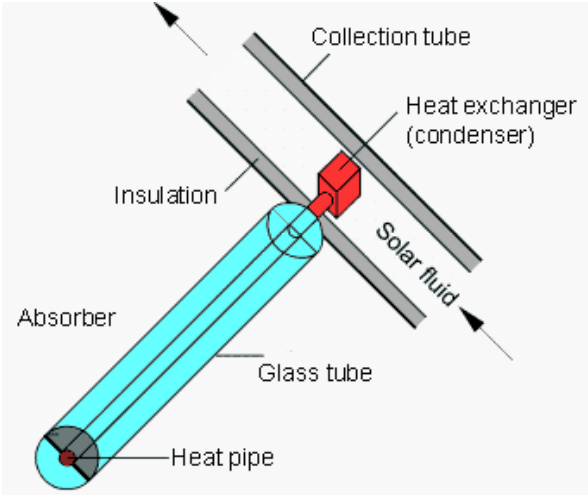
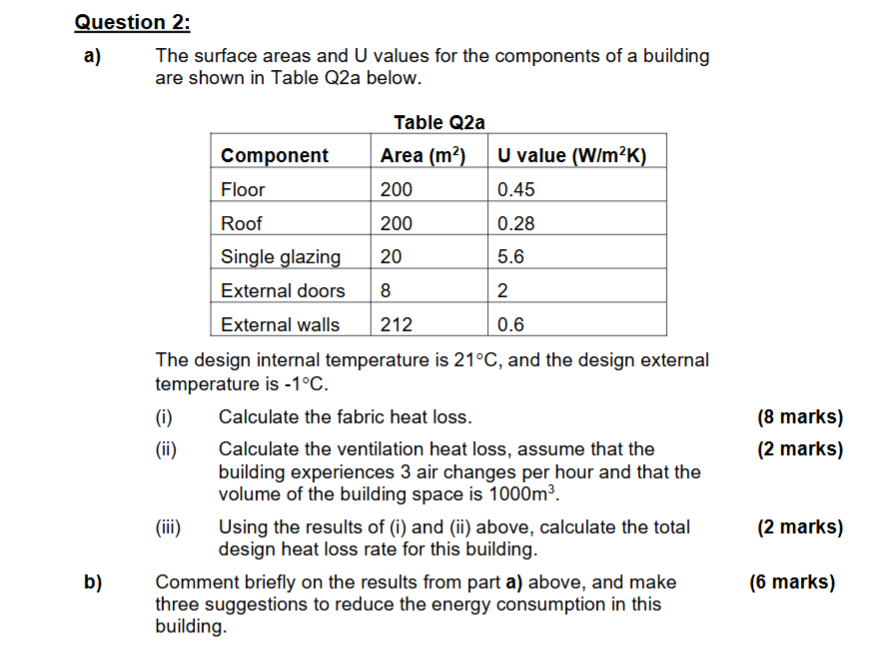
b)The ventilation heat loss (21,780 W) is over twice the fabric heat loss (8,826 W). This indicates that air infiltration and exchange are the dominant causes of energy loss in this building.
Three Suggestions to Reduce Energy Consumption:
Improve Air Tightness
Reduce uncontrolled air infiltration using better sealing, door sweeps, and caulking.
Install Mechanical Ventilation with Heat Recovery (MVHR)
Recover heat from exhaust air, significantly reducing ventilation losses.
Upgrade Glazing and Insulation
Replace single glazing with double/triple-glazing. Improve insulation in walls and roof to reduce U-values.
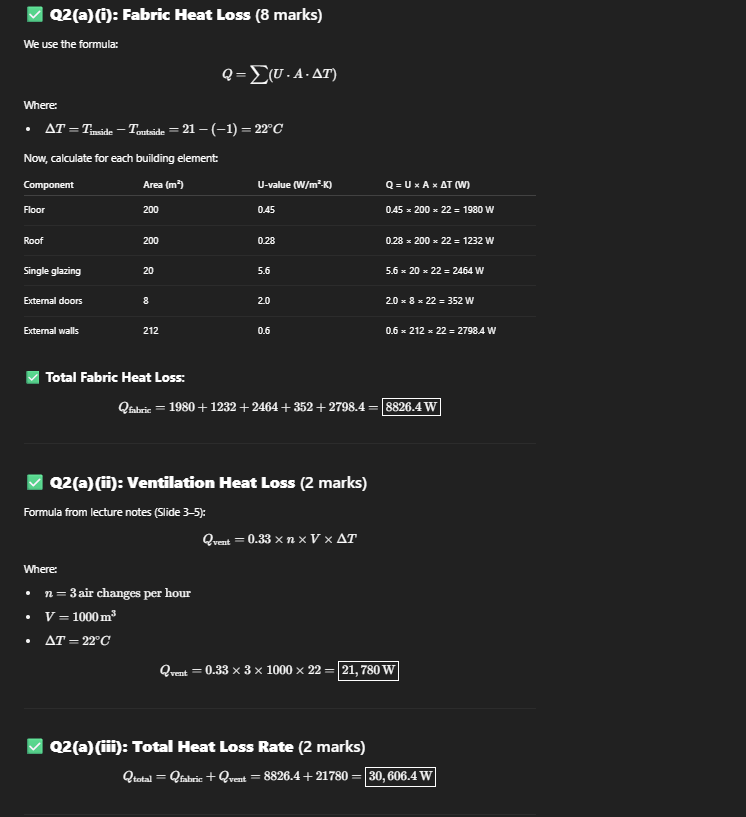
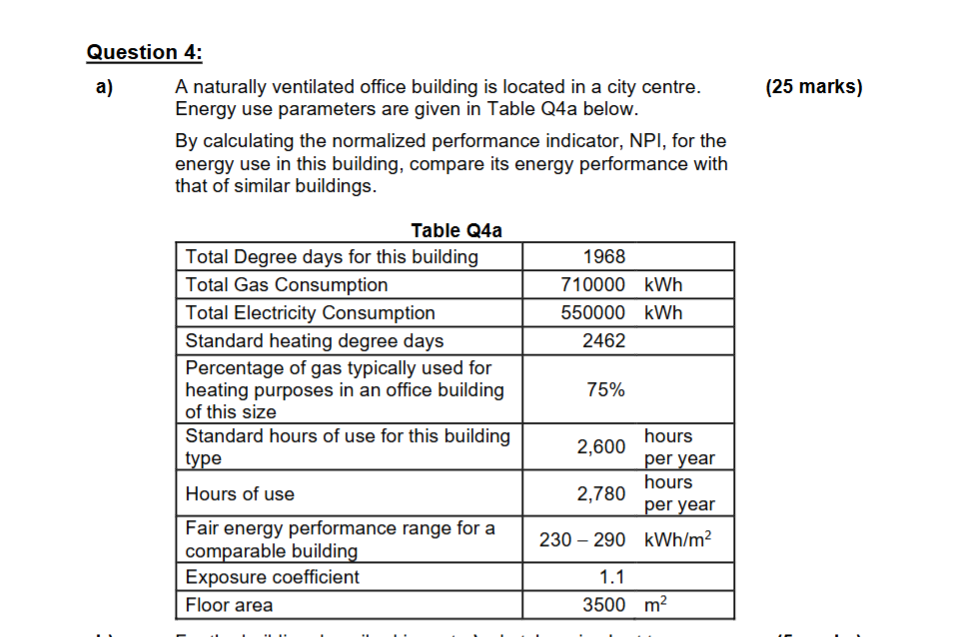
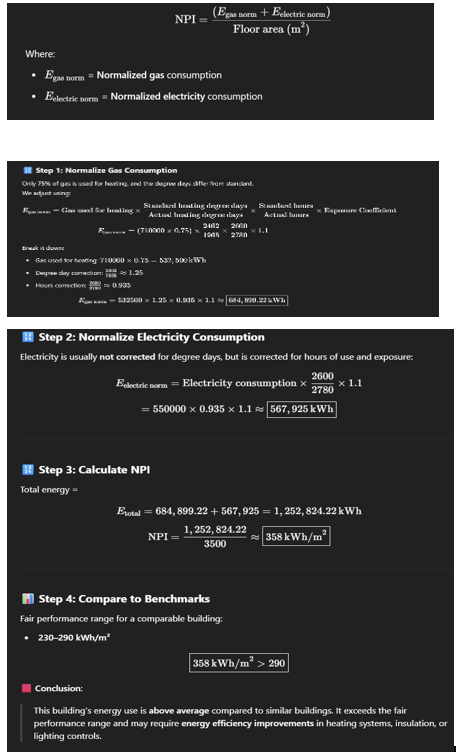
Explain the three processes of heat transfer, using practical
examples and diagrams to help support your answer
Heat transfer by conduction occurs in solids, liquids or gases.
In solids, it is the result of the vibration of the atoms or molecules and the energy is transferred without actual movement of the atoms. Example: Heat travelling through a radiator panel, or through the walls of a boiler to the surrounding air.
Convection is the transfer of heat by the movement of fluids (liquids or gases). Warm fluid rises, cool fluid sinks.”
In a heated room, warm air rises above a radiator and cool air descends to take its place, forming a convection current.
Radiation is the transfer of energy by electromagnetic waves. It does not require a medium — can occur in a vacuum. Solar radiation warming your skin, or a radiant panel heater heating objects directly in a room.
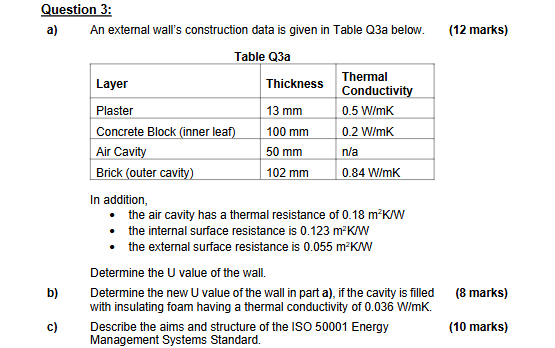
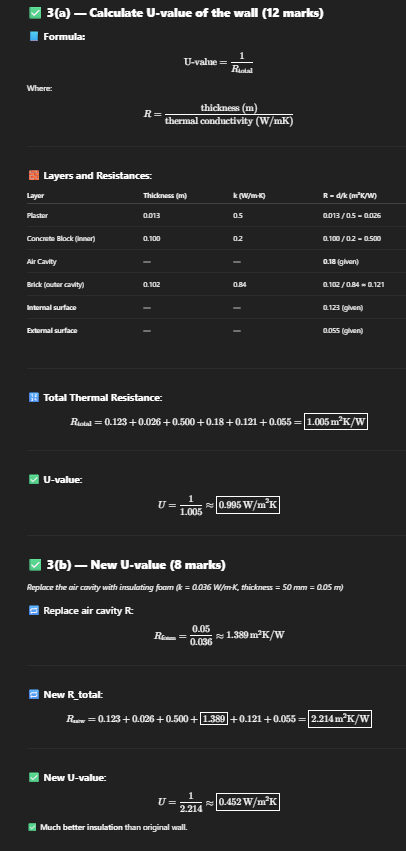
5 causes of sub-meter data error
Communication failure between meter and system
Incorrect time stamps
Calibration error in meter
Data formatting issues (unit mismatch)
Manual data entry mistakes
The power contained in a wind stream travelling at 8 meters per
second has been estimated at 12 kW for a specific swept area.
Calculate the required diameter of the blades of a wind turbine
that would optimize the extraction of the wind power (assume
the density of air is 1.2 kg/m3)
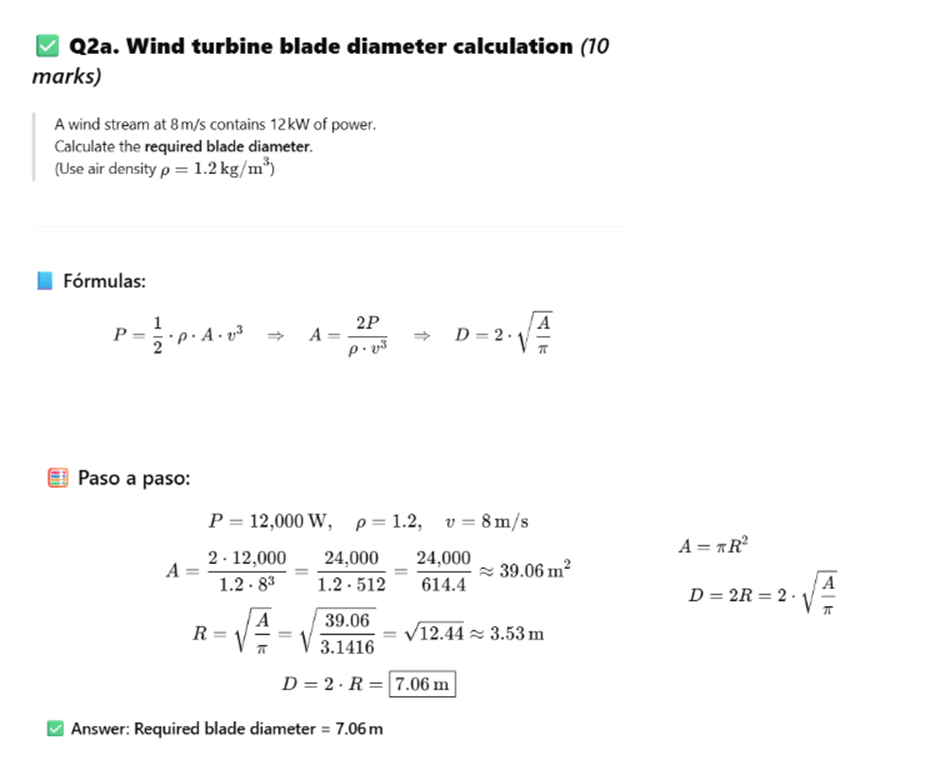
Heat loss calculation: What is the fabric loss in watts through a
floor area of 300m², U value of 0.45W/m²K, where the inside
temperature is 20°C and the outside temperature is 5°C?

Discuss why modern large wind turbines use a braking system and describe three methods of braking systems.
Modern large wind turbines use braking systems to:
Prevent mechanical damage during high wind speeds or storms.
Excessive rotor speeds can stress or break turbine blades, shafts, or gearboxes.
Ensure safe maintenance and shutdown.
Turbines must be stopped for servicing or emergencies.
Regulate rotor speed for optimal power output.
Over-speeding reduces efficiency and increases wear
Three Methods of Braking Systems
Aerodynamic Braking (Blade Pitch Control):
Blades rotate (feather) to reduce lift and slow down.
Used in most modern turbines.
Automatic and smooth control during high winds.
Mechanical Braking (Disc Brakes):
Similar to car brakes, used on the turbine shaft.
Engaged during emergencies or shutdowns.
Cannot be used alone due to wear.
Electrical Braking (Dynamic or Resistive):
Converts excess electrical energy into heat using resistors.
Used when turbines disconnect from the grid.
Helps slow the generator without physical wear.
Outline two reasons for energy management in Ireland.
Reduce Energy Costs and Improve Efficiency:
Businesses and public sector bodies can cut energy bills and reduce waste through better monitoring and control.
Meet Climate and Sustainability Targets:
Ireland must reduce carbon emissions under EU and national climate action plans.
Energy management helps organizations align with ISO 50001 and meet legal and sustainability commitments.
b) A 230 V single-phase electric motor has the following name-plate
ratings.
Rated mechanical power 0.75 kW
Efficiency at rated load 60 %
Rated RMS current 6.8 A
Determine the power factor of the motor, and the phase angle. Is this
a leading or a lagging load
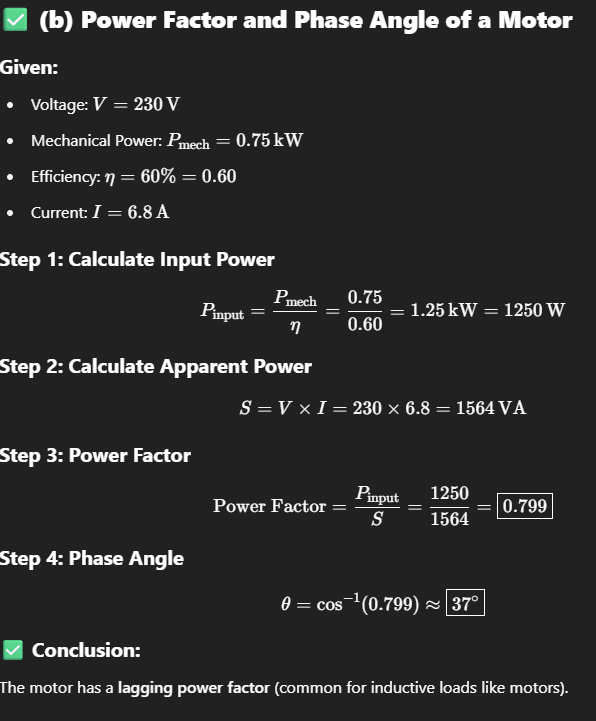
d)Calculate the kWh equivalent of 5,800 m3 of natural gas, given that its
net calorific value of natural gas is 35.2 MJ/m3.
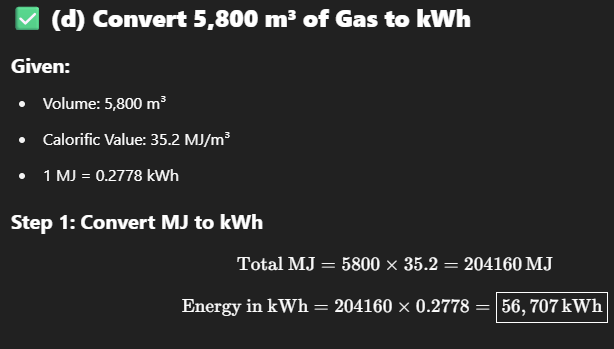
g) The open-circuit voltage of a photovoltaic solar module is specified as
35.5 volts. Its short circuit current specification is 6.25 amps. Sketch
on the same graph, the V-I characteristics of the module at both 25°C
and at 75°C. Estimate the power rating of the module
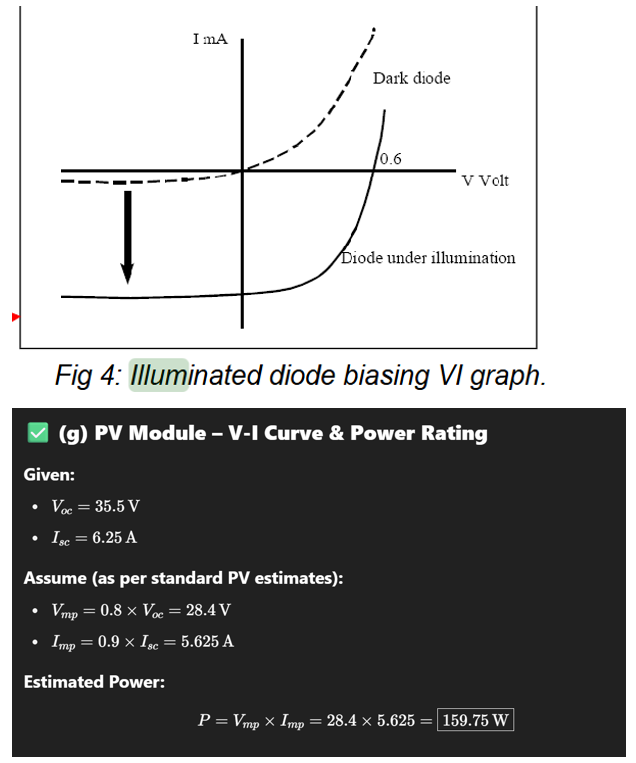
It is planned to design a wind turbine to deliver 400 kW of electrical
power in a wind stream travelling at 8 metres per second.
(i) Neglecting generation losses, calculate how much wind
power would need to be captured to produce the rated
output power. Explain your answer

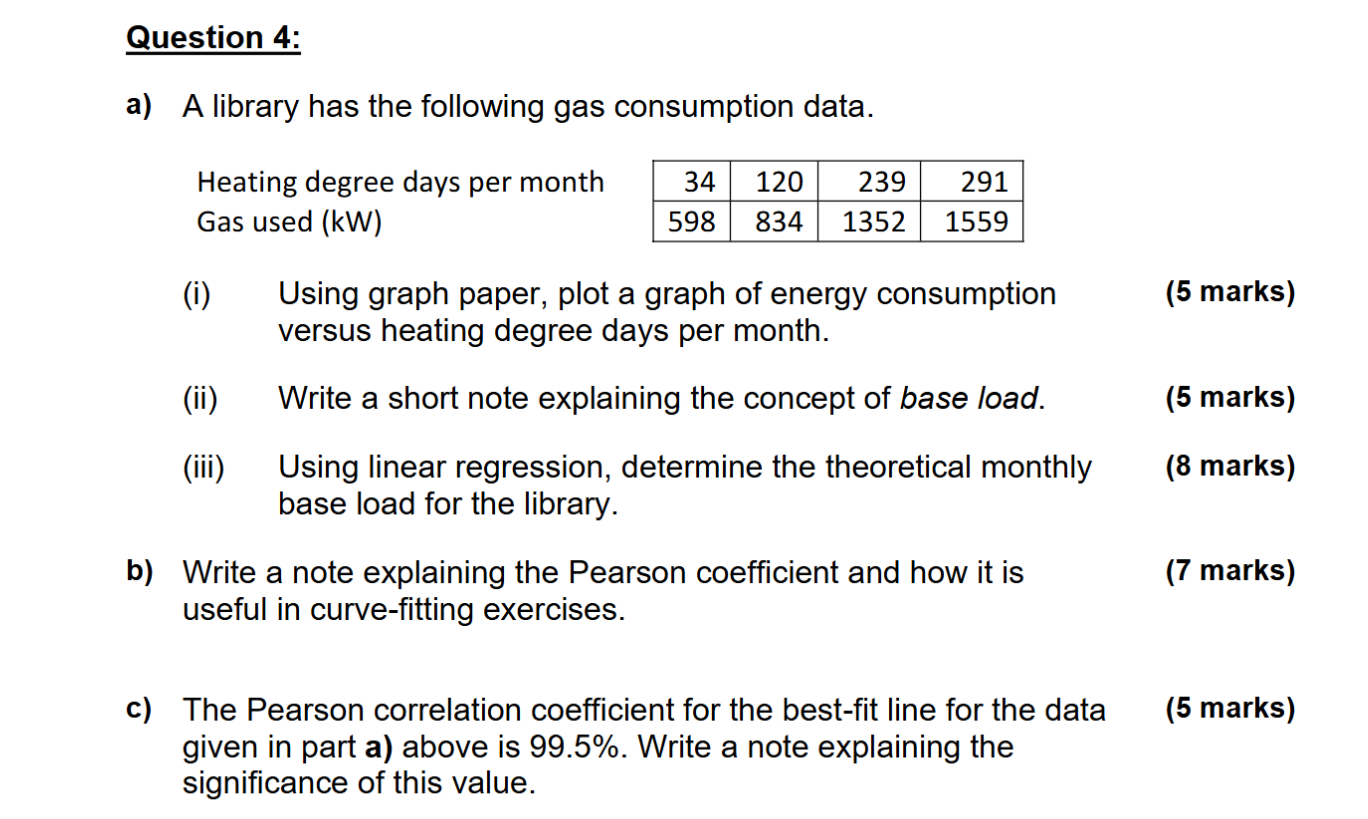
b) The Pearson correlation coefficient (r) measures how strongly two variables are linearly related.
Value ranges from –1 to +1
r = +1: perfect positive correlation (as one increases, so does the other)
r = 0: no linear relationship
Use in energy analysis:
Shows how well energy use is explained by degree days.
A high r means the regression line is a reliable model for predicting energy use.
c)A correlation of 0.995 (or 99.5%) means there is a very strong linear relationship between heating degree days and energy use.
This suggests:
Most of the energy variation is directly related to heating demand.
The linear regression model is highly accurate.
In real-world terms:
"Almost all variation in gas consumption can be explained by the number of heating degree days."
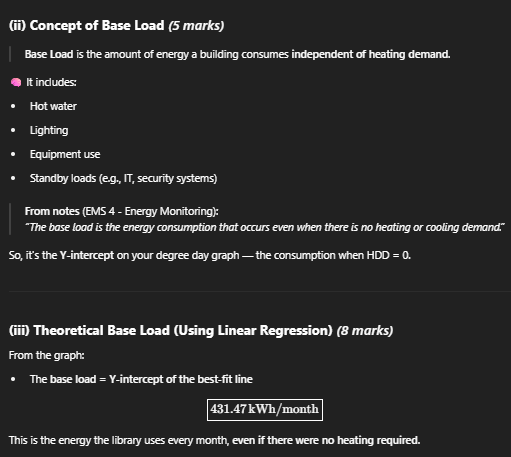
Explain the term Primary Fuel, using examples to support your
answer
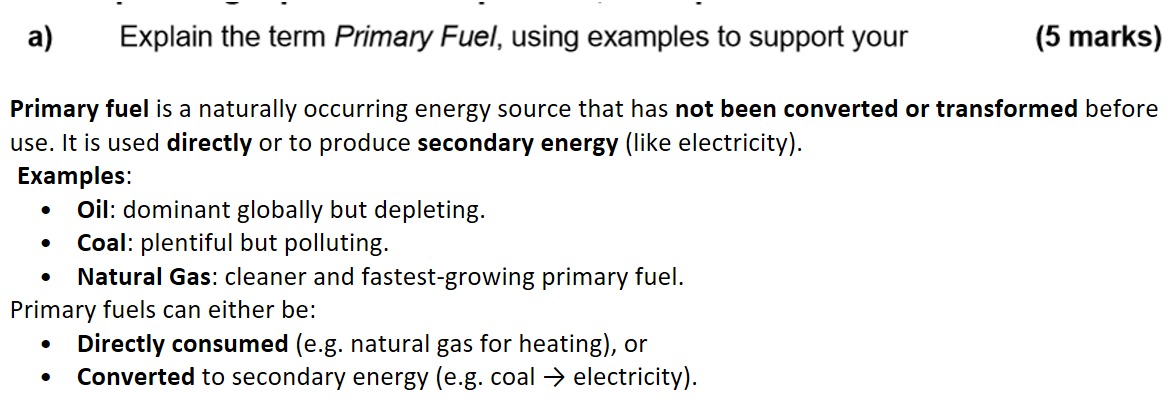
First Law of Thermodynamics
energy cannot be created or destroyed, only converted from one form to another. example: In a boiler, chemical energy in fuel is converted into thermal energy in hot water or steam.
Explain briefly why correction factors are required when a building is
heated intermittently, and list these correction factors.
hen a building is not heated continuously, correction factors account for:
Start-up heating loads
Building heat inertia
Temperature lags
Use a sketch to explain the reason for using low-emissivity glazing.
Sunlight (shortwave radiation) enters freely from the outside through the glazing.
The Low-E coating, applied to the inner surface of the inner glass pane, reflects infrared (IR) radiation (heat) back into the room.
This helps to reduce heat loss from the building, improving thermal efficiency.
